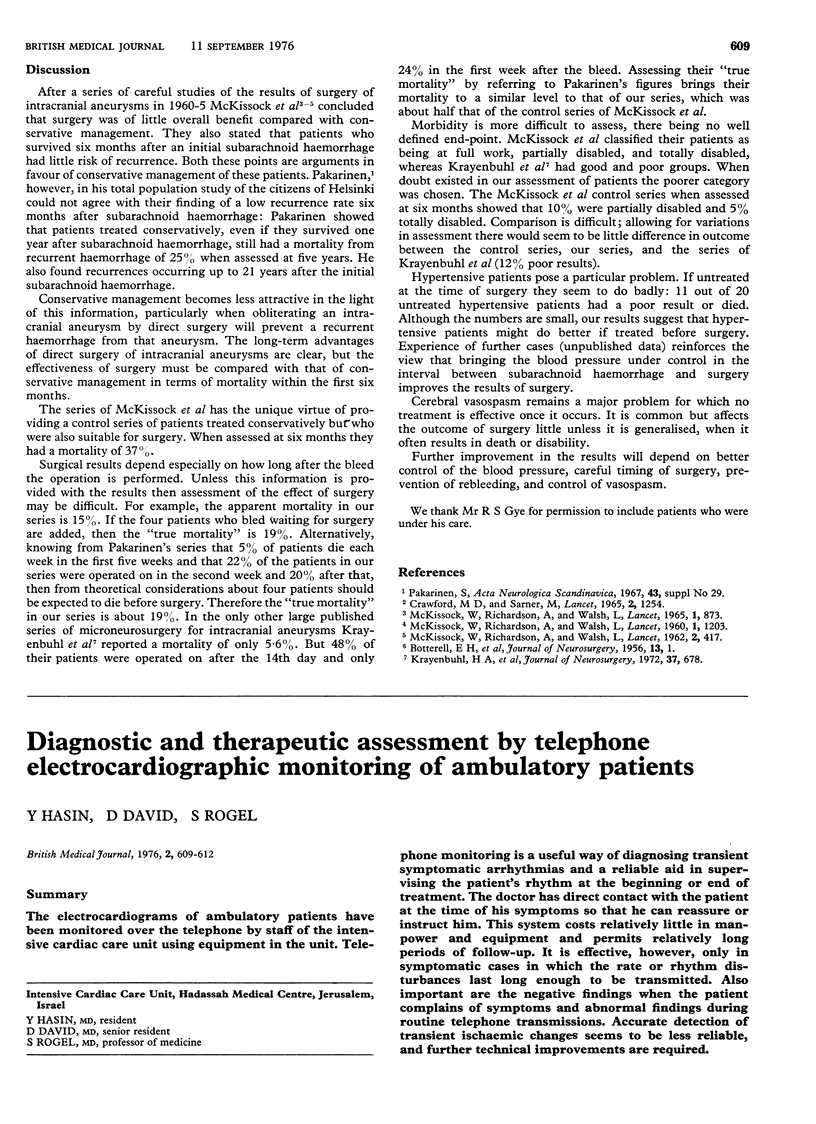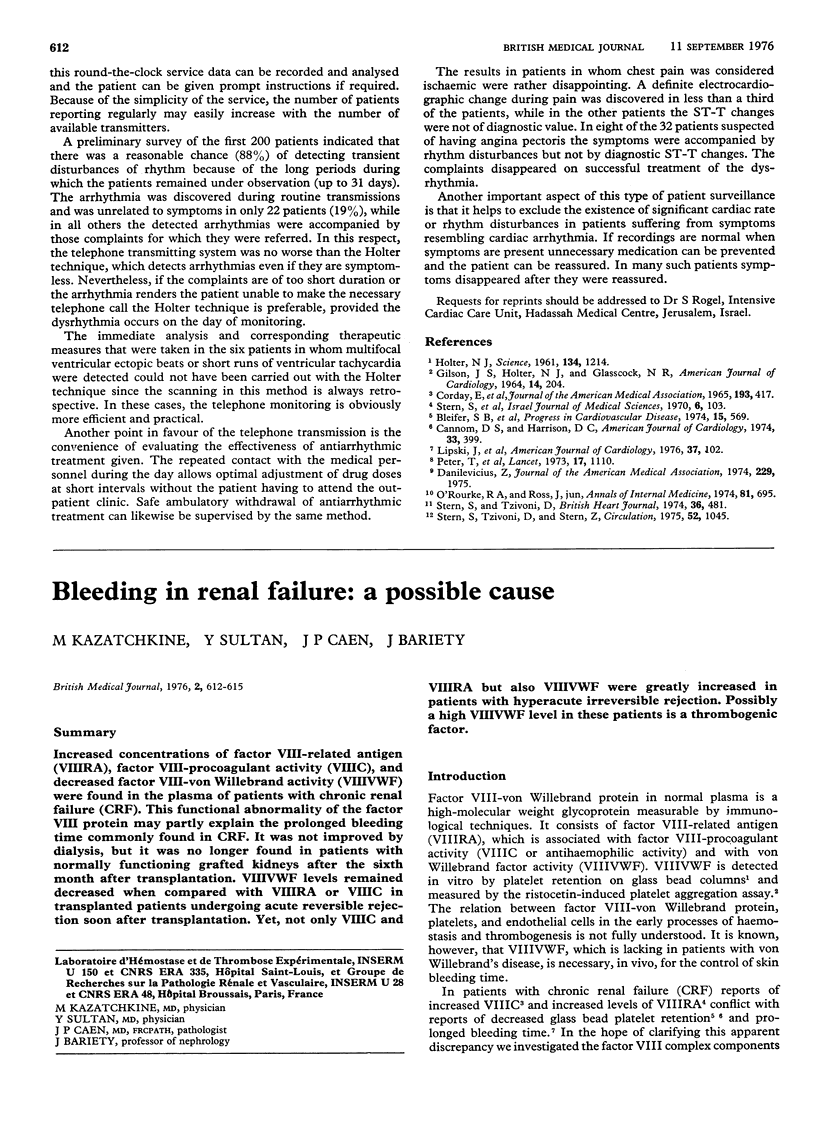Abstract
The electrocardiograms of ambulatory patients have been monitored over the telephone by staff of the intensive cardiac care unit using equipment in the unit. Telephone monitoring is a useful way of diagnosing transient symptomatic arrhythmias and a reliable aid in supervising the patient's rhythm at the beginning or end of treatment. The doctor has direct contact with the patient at the time of his symptoms so that he can reassure or instruct him. This system costs relatively little in manpower and equipment and permits relatively long periods of follow-up. It is effective, however, only in symptomatic cases in which the rate or rhythm disturbances last long enough to be transmitted. Also important are the negative findings when the patient complains of symptoms and abnormal findings during routine telephone transmissions. Accurate detection of transient ischaemic changes seems to be less reliable, and further technical improvements are required.
Full text
PDF



Images in this article
Selected References
These references are in PubMed. This may not be the complete list of references from this article.
- Bleifer S. B., Bleifer D. J., Hansmann D. R., Sheppard J. J., Harold H. L. Diagnosis of occult arrhythmias by Holter electrocardiography. Prog Cardiovasc Dis. 1974 May-Jun;16(6):569–599. doi: 10.1016/0033-0620(74)90019-x. [DOI] [PubMed] [Google Scholar]
- CORDAY E., BAZIKA V., LANG T. W., PAPPELBAUM S., GOLD H., BERNSTEIN H. DETECTION OF PHANTOM ARRHYTHMIAS AND EVANESCENT ELECTROCARDIOGRAPHIC ABNORMALITIES: USE OF PROLONGED DIRECT ELECTROCARDIOCORDING. JAMA. 1965 Aug 9;193:417–421. doi: 10.1001/jama.1965.03090060007001. [DOI] [PubMed] [Google Scholar]
- Cannom D. S., Harrison D. C. Detection of ventricular arrhythmias in real-time with a portable analog computer. Am J Cardiol. 1974 Mar;33(3):399–402. doi: 10.1016/0002-9149(74)90322-1. [DOI] [PubMed] [Google Scholar]
- GILSON J. S., HOLTER N. J., GLASSCOCK W. R. CLINICAL OBSERVATIONS USING THE ELECTROCARDIOCORDER-AVSEP CONTINUOUS ELECTRODIOGRAPHIC SYSTEM. TENTATIVE STANDARDS AND TYPICAL PATTERNS. Am J Cardiol. 1964 Aug;14:204–215. doi: 10.1016/0002-9149(64)90134-1. [DOI] [PubMed] [Google Scholar]
- HOLTER N. J. New method for heart studies. Science. 1961 Oct 20;134(3486):1214–1220. doi: 10.1126/science.134.3486.1214. [DOI] [PubMed] [Google Scholar]
- Lipski J., Cohen L., Espinoza J., Motro M., Dack S., Donoso E. Value of Holter monitoring in assessing cardiac arrhythmias in symptomatic patients. Am J Cardiol. 1976 Jan;37(1):102–107. doi: 10.1016/0002-9149(76)90507-5. [DOI] [PubMed] [Google Scholar]
- O'Rourke R. A., Ross J., Jr Ambulatory electrocardiographic monitoring to detect ischemic heart disease. Ann Intern Med. 1974 Nov;81(5):695–696. doi: 10.7326/0003-4819-81-5-695. [DOI] [PubMed] [Google Scholar]
- Peter T., Harper R., Luxton M., Pring M., McDonald R., Sloman G. Personal telephone electrocardiogram transmitter. Lancet. 1973 Nov 17;2(7838):1110–1112. doi: 10.1016/s0140-6736(73)90932-x. [DOI] [PubMed] [Google Scholar]
- Stern S., Tzivoni D. Early detection of silent ischaemic heart disease by 24-hour electrocardiographic monitoring of active subjects. Br Heart J. 1974 May;36(5):481–486. doi: 10.1136/hrt.36.5.481. [DOI] [PMC free article] [PubMed] [Google Scholar]
- Stern S., Tzivoni D., Stern Z. Diagnostic accuracy of ambulatory ECG monitoring in ischemic heart disease. Circulation. 1975 Dec;52(6):1045–1049. doi: 10.1161/01.cir.52.6.1045. [DOI] [PubMed] [Google Scholar]







